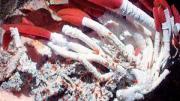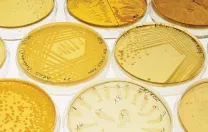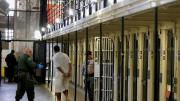Interdisciplinary science like that supported by the Microbial Sciences Initiative depends heavily on training the next generation of researchers: junior faculty members who use unconventional tools to probe new questions. “The real future of the place,” says Fisher professor of natural history Andrew Knoll, “is in these people.” Here are portraits of three such young scientists at Harvard.
Evolution in Action
“Nature on the small scale,” says assistant professor of organismic and evolutionary biology Christopher Marx, “is just as interesting as nature on the savanna that you grew up watching on TV.” Marx studies evolution in the lab, using bacteria that grow on methanol.
With a population of a billion bacteria, one that doubles in size every eight hours, he can perform true experiments in evolution. In contrast, he notes that “even in a herd of 100 cows, in which you select, for example, the fattest in each generation, there is such a small amount of genetic variability that you are really selecting for new combinations of alleles,* and not for new alleles occurring, because the chance of a new, useful gene arising in 100 cows is relatively low per generation. Here [in the lab], a lot happens every day. One out of every thousand bacterial ‘babies’ has a mutation somewhere, which is not much”—but with a billion new bacteria in each generation, that is a million new mutations every day. “The genome size of [the bacterium I work on] is about seven million base pairs,” he says, “so in seven generations you will have tested, on average, every single site, so you can quickly generate many different variants for selection to act upon.”
“Organisms that eat methanol are sprinkled all over the bacterial tree of life,” Marx continues. “But if you look at the genes involved, the sequences are in almost all cases highly related.” What has happened is called “horizontal gene transfer,” the exchange of genetic material between different kinds of bacteria: in this case, an entire “cassette” of perhaps a hundred genes that control metabolism. Marx wants to see what physiological steps take place after a gene transfer like this, in hope of extrapolating principles that might allow him to predict the probability of any particular beneficial mutation taking place before another.
Feature Article:
One of the byproducts of metabolizing methanol is formaldehyde, which kills most living things. Because Marx’s “bugs” neutralize formaldehyde by oxidizing it, he decided to see what would happen if he swapped the genes that generate their formaldehyde oxidation pathway for a completely different set of genes from an unrelated bug. “It is as if you ripped a gasoline engine out of a car and replaced it with an electric motor,” he says. “This is different chemistry—different pathways, and different intermediates—but it gets you from the same point A to point B on the metabolic map.” There was no guarantee that the experiment would work—but luckily, it did. “With this new pathway, these bugs can still grow on methanol,” Marx reports. “But what’s most interesting is that they do so three times more slowly and are only 40 percent as efficient.” But as the bugs evolved using the new pathway, their fitness improved. After 120 generations, fitness had doubled. At present, after 600 generations, they reproduce almost as quickly as the original strain does with the original pathway. Marx freezes samples of the bugs at different stages of their evolution so that later he can analyze the sequence and timing of the physiological changes that led to their improved fitness.
Fueling Deep-sea Discovery
Assistant professor of organismic and evolutionary biology Peter Girguis studies “ecological physiology,” the physiology of groups of uncultured microbes that live at hydrothermal vents 2,500 meters deep in the ocean, where the pressure—about 4,000 pounds per square inch—is “the equivalent of a small car being balanced on your thumbnail.”
“If you go to the sea floor, you can measure changes in methane concentration or butane, or nitrate or sulfate, but we often don’t know exactly which organisms are responsible,” he says. Because groups of microbes living in complex ecologies can be difficult to understand, Girguis sometimes brings samples back to the lab, where he recreates marine environments with clever engineering: simulating the pumping action of tides on sediments, for example. Then he perturbs the system—perhaps by adding oxygen—to see how the microbes respond. “We are focusing mainly on natural perturbations,” he says, “but anthropogenic ones are equally important.” He notes that there has been a lot of talk about managing the greenhouse-gas problem by sequestering carbon in the deep ocean (by capturing carbon-dioxide emissions from fossil-fuel-burning power plants and storing them in liquid form atop the ocean floor 3,000 meters or more below the surface, where the waste could remain for millions of years; see “Fueling Our Future,” May-June 2006, page 40). “That makes me nervous,” he says, “because I think the response of the microbes may be quite different from what we assume.”
Many of Girguis’s experiments take place in the field, but running the necessary equipment in the deep ocean, with its high pressure and extreme cold, can be very expensive. It takes 125 size “D” alkaline batteries to provide power for a year to a half-watt device like a bike lamp, so Girguis has enlisted the aid of microbes to solve his on-site fuel problem. A microbial fuel cell is less affected by the temperature and pressure, and can run as long as 15 years without needing a “charge” of fresh organic matter. (Girguis runs a pair of demonstration cells in his office on cow manure.)
He compares what the microbes are doing—generating electricity—to what we do when we eat a cheeseburger. “All life on Earth,” he explains, “is pretty much about moving electrons.” When you eat, “what you are doing is taking all the electrons that are tied up in that organic matter—in the burger and the cheese and the bun and the secret sauce—and moving those electrons through your respiratory pathways,” harnessing their energy in the process. “Then you are going to dump the electrons onto oxygen—you need that oxygen because it is like an electron magnet—and you ditch the oxygen, electrons, and some carbon [as carbon dioxide].
“Microbes do the same thing, but they can also dump the electrons onto sulfates, nitrates, and even solids. And this is where it gets crazy. They are capable of shuttling electrons from reduced organic matter through their biochemical pathways, generating energy, and then sticking those electrons onto a chemical that they shuttle outside their bodies and then dumping [the ‘shuttle,’ thereby depositing] the electrons onto iron or another solid-phase oxidant.” Some microbes don’t need the chemical shuttle at all, he reports: “They just dump their electrons through little conductive nanowires. That is like you eating a cheeseburger and being able to respire it without oxygen. It is like holding your breath and dumping your electrons onto my filing cabinet. That is the premise behind microbial fuel cells. You can set up a microbial fuel cell, encourage the growth of microbes that can shuttle electrons and break down the organic matter in an environment, and then have them dump those electrons onto the fuel cell and harness that energy.”
Girguis’s fuel cells generate enough electricity to run a light bulb, power a wireless network, or charge a cell phone. His aspiration to power lights in the developing world has led to a collaboration with two Harvard Business School graduates who hope to bring a product to market. Says Girguis with a grin, “Microbes really run everything.”
The Clean-up Conundrum
One of the things that attracted Colleen Hansel to Harvard last January was the energy she saw going into the Microbial Sciences Initiative. An assistant professor of environmental microbiology in the School of Engineering and Applied Sciences, she studies microbial interactions with metals. The work is important for cleaning up toxic waste, for improving agricultural practices and human health, and even for understanding planetary history.
Hansel has worked on cleaning up sites contaminated with metals such as arsenic, chromium, and technetium. More and more research, she says, is showing “an interesting correlation” between antibiotic resistance and microbial resistance to metals. Microbes that have developed genes enabling them to resist antibiotics can withstand higher metal concentrations and therefore may no longer detoxify them. Such resistance is growing rapidly, because antibiotics are becoming common in the environment, streaming from animal feed lots and even household sewage. They can even arise spontaneously as a response to toxic-waste cleanup efforts.

Photographs by Andrew Knoll
These 2.5 billion-year-old sedimentary rocks in Karijini National Park, northwestern Australia, contain layers of iron that has been oxidized. Such “banded iron formations” (detail below) may allow geologists to determine when oxygen first appeared in Earth’s atmosphere.

“The strategy we use to clean up a site,” Hansel explains, is to provide additional food for the microbes that are capable of immobilizing metals. “That,” she says, “will stimulate the microbes to increase their metabolism and clean up the soils and sediments.” Clean-up crews pump a carbon compound such as glucose or lactate into the soil. The organisms respond by achieving “higher densities and higher growth yields,” she says. But they also “start producing antibiotics, because they want to kill off their competitors.” Stimulating the production of antibiotics has the unfortunate consequence of providing selective pressure for antibiotic-resistant genes, which move between microorganisms much faster than other kinds of genes.
“Are we doing some harm when we are trying to do some good?” she wonders. Microbes reduce or oxidize metals in order to gain energy or detoxify themselves, she explains. But if the microbes become resistant to the metals, as they do when they acquire antibiotic resistance genes, they no longer do this useful work. Meanwhile, they are also introducing many more antibiotic-resistant genes (potentially of danger to humans) into the environment.
Hansel’s research into the oxidation of iron and manganese (primarily for use in cleaning contaminated sites) may also help answer geological questions. Banded iron formations—sedimentary deposits of rock billions of years old in which the iron and manganese layers have been oxidized—are often cited as evidence of oxygen in earth’s early atmosphere. “But the big question,” says Hansel, “is whether or not oxygen is needed to form these iron oxides. Is the process abiotic, or were microbes involved?”
Unlike iron, manganese is very hard to oxidize, she says. But certain organisms that she has isolated from contaminated sites produce a molecule during their growth that oxidizes the metal when exposed to light. “The bacterium is not oxidizing the metal itself,” she emphasizes, it is just producing a photoreactive organic molecule. “Could there have been organics present two billion years ago, during the Pre-Cambrian when the banded iron formations appeared, that were photoexcited and oxidized manganese?” It is the sort of exciting question—bearing on the origins of life and the creation of the biosphere—that she hopes to explore with her new colleagues. But she acknowledges, “I find microbes are humbling, too. The more you understand, the more you realize just how diverse they are.”







